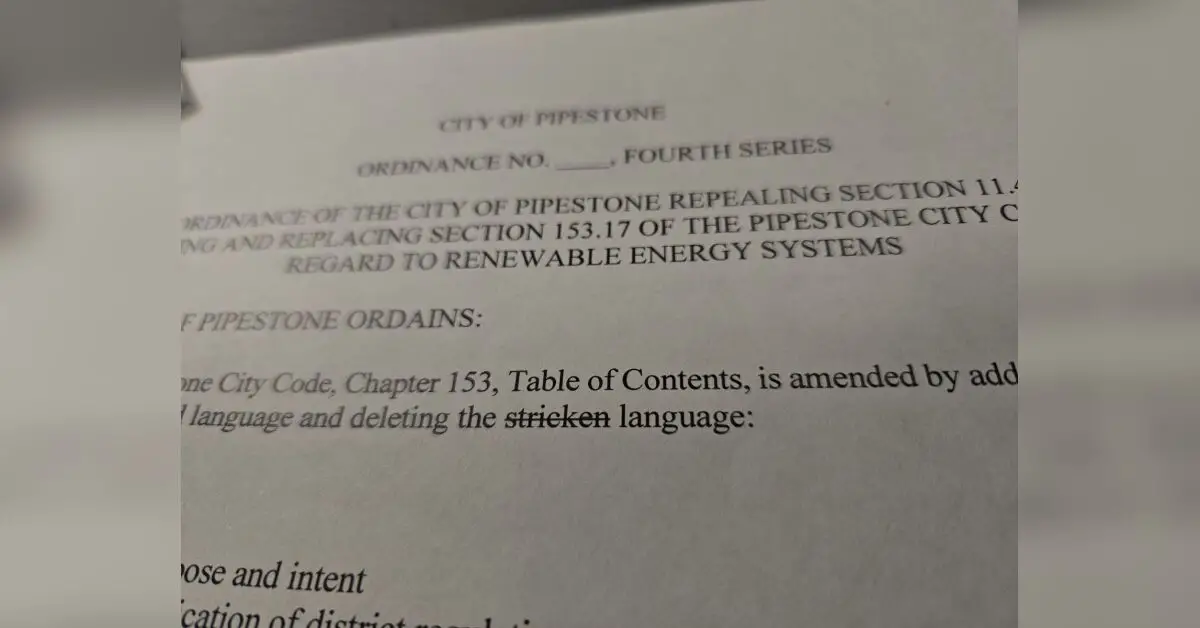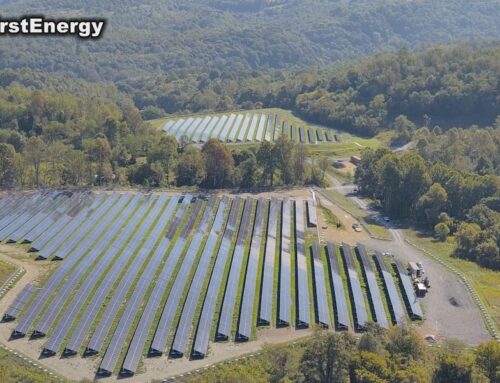Updated renewable energy ordinance recommended
October 17, 2024

The Pipestone Planning Commission during its Oct. 9 meeting recommended that the Pipestone City Council approve an updated renewable energy systems ordinance.
The Pipestone City Council approved an interim ordinance earlier this year that authorized a study by the planning commission and imposed a moratorium on the establishment, construction or expansion of renewable energy facilities within the city to give the planning commission time to conduct the study. Pipestone Building and Zoning Administrator Solomon Derby said then that the language about solar facilities in the existing ordinance, which was adopted in 2021, appeared to have contradictions, was lacking specificity and was missing information, which made it difficult for him to answer questions when people called about solar arrays.
The proposed new ordinance indicates that the city “finds it is in the public interest to encourage the use and development of renewable energy systems that enhance energy conservation efforts but result in limited adverse impact on nearby properties.”
Solar energy systems
The proposed ordinance pertains to solar energy systems that are capable of generating less than 50 megawatt (MW) of power. Any system capable of generating more than that falls under the jurisdiction of the Minnesota Public Utilities Commission (PUC), according to the ordinance.
That 50 MW definition was questioned during a previous meeting on Oct. 2. Pipestone Building and Zoning Official Solomon Derby said he had since reached out to the city’s attorney, Jason Hill, and was told that such language was included to make it clear that the city cannot regulate or ban systems of that size, and that they are under the jurisdiction of the PUC.
All solar energy systems would have to comply with applicable electric codes and building codes; all building-mounted solar energy systems, other than roof-mounted systems, are
prohibited; and all solar systems are prohibited in the city’s flood way district. Solar energy systems in any other floodplain zoning district must comply with all applicable federal, state and local floodplain regulations.
Non-commercial systems are defined as those capable of generating less than 50 kilowatt (kW) of power, are considered accessory to the principal land use and are designed to supply energy for the principal use. They are allowed in all zoning districts except the floodway district.
Such systems can be roof-mounted or ground mounted. Roof-mounted systems cannot project more than 4 feet above the plane of the roof or be located closer than 3 feet from the outer edge of the roof top; cannot occupy more than 75 percent of the area of the roof; and require a building permit. Ground-mounted systems must comply with setback requirements; cannot exceed 15 feet in height; cannot be located in any front yard; cannot be located closer than 100 feet from an existing adjacent residence; cannot exceed 10 percent of lot coverage or 10,000 square feet, whichever is less; and require a building permit.
Commercial solar energy systems are defined as those capable of generating 50 kW or more and are designed to supply energy for off-site users or export to the wholesale market on the distribution grid. They include solar gardens or community solar energy systems, and solar farms. They are allowed in light industrial, general industrial and conservation districts, excluding any properties in the floodway district, and require a conditional use permit.
Solar gardens are defined as systems that provide retail electric power to multiple community members or businesses off-site from the system. They may be either an accessory or a principal use.
Solar gardens must be located on parcels no less than five acres in size. They must meet setback requirements from lakes, rivers, streams, protected wildlife areas, wetlands, residences, buildings, roads and property lines; must have ground cover that meets the state’s beneficial habitat standards and wildlife-friendly fencing; and must have a decommissioning plan.
Solar farms must be located on parcels five acres or more in size; meet setback requirements for lakes, river, streams, protected wildlife areas, wetlands, residences, buildings, roads and property lines; must have screening; must have ground covering that meets the beneficial habitat standards; must have wildlife-friendly fencing; must be designed to prevent any stray voltage from affecting adjacent properties or interfering with the operation of electrical appliances or electronic equipment on adjacent properties; must follow noise standards; and must have a decommissioning and site plan.
Wind energy conversion systems
According to the proposed ordinance, it governs wind energy conversion systems capable of generating less than 5 MW of power. The state has jurisdiction over systems that generate 5 MW or more.
Wind energy conversion systems are allowed in general industrial zoning districts, excluding property in the floodway district, and are prohibited in all other zoning districts. They require a conditional use permit.
Applicants must provide a description of the project, a site plan and a decommissioning plan; and comply with setback requirements. Their placement cannot diminish the public enjoyment of scenic highways, overlooks or parks; the rotor blades cannot be closer than 30 feet from the ground; and they are considered discontinued after six months without energy production. All wind energy conversion systems must comply with applicable noise, electrical and FAA requirements; must be fenced in unless towers are designed without ladders or accessible climbing devices; must be designed to prevent any stray voltage from affecting adjacent properties or causing interference with the operation of electrical appliances or electronic equipment on adjacent properties.
Non-commercial wind energy systems cannot exceed 150 feet. Commercial systems are prohibited within 2,640 square feet of any occupied residence or business, 750 feet of a lake, river, stream and protected wildlife habitat, and wetlands to the extent prohibited by the Minnesota Wetland Conservation Act.
The proposed ordinance is expected to be introduced during the city council’s Oct. 21 meeting. The council could then consider adopting it at its Nov. 4 meeting.
Search
RECENT PRESS RELEASES
Related Post



